I know apples are the best fruits in this world. So many people surrounded this apple such as many questions such as Can cats eat apples? Yes, cats can eat apples in moderation. They can be a healthy treat for your feline friend, providing essential vitamins, minerals, and fiber. However, it’s important to remember a few key points: Imagine a crisp autumn day. The leaves are turning hues of gold and crimson, and a gentle breeze carries the sweet scent of apples. A sleek, tabby cat sits perched on a windowsill, watching the world go by. A juicy, red apple is placed before them. With a curious tilt of the head, the cat cautiously reaches out a paw, sniffing the fruit before taking a tentative bite. The crunch of the apple is followed by a contented purr as the cat savors the sweet, tart flavor. It’s a simple moment, but one filled with pure joy and contentment.
Table of Contents
Is apple a good treat for cats?
Absolutely! Apples can be a delightful and nutritious treat for your feline friend. While they may not be as natural a choice as some other cat foods, apples offer a variety of benefits that can enhance your cat’s overall health and well-being.
The crisp, juicy texture of an apple can be a refreshing change from the usual dry kibble or wet food. And with their sweet, slightly tart flavor, apples can tantalize your cat’s taste buds and provide a satisfying snack. But it’s not just about taste. Apples are packed with essential vitamins, minerals, and antioxidants that can support your cat’s immune system, digestion, and overall vitality.
So, the next time you’re enjoying a piece of apple, consider sharing a small slice with your furry companion. Just remember to remove the core and seeds, as these parts can be harmful to cats. With a little care and moderation, apples can become a favorite treat that your cat will eagerly anticipate.
Can cats eat apple slices?
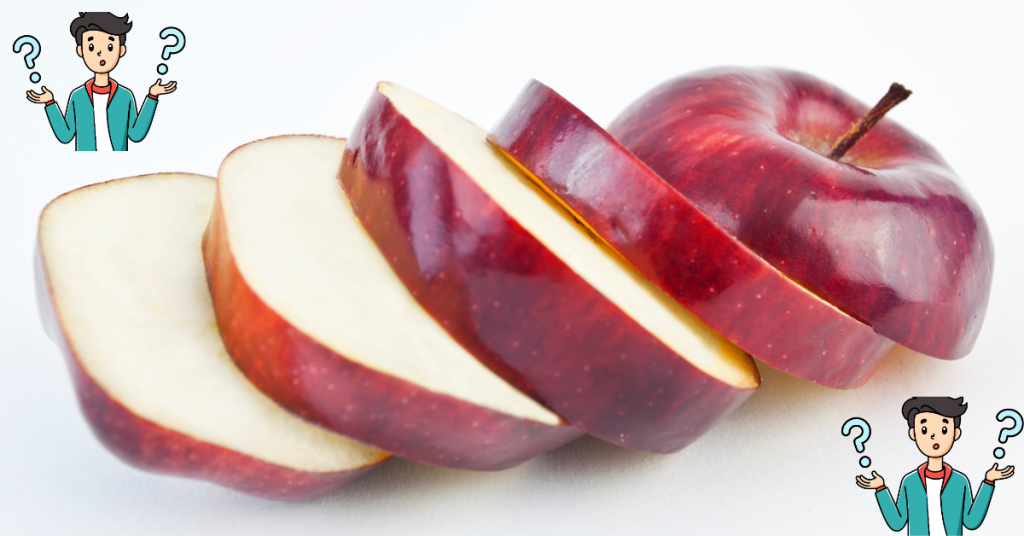
Yes, cats can eat apple slices, but only as an occasional treat. Apples are safe for cats when prepared correctly, but they should never replace a cat’s primary diet. Always remove the seeds and core, as they contain harmful substances, and peel the skin to avoid digestive issues. Offer only small, bite-sized pieces, and watch your cat’s reaction—some cats might love the taste, while others might not be interested. Remember, moderation is key, and apples should be a rare indulgence, not a regular snack.
When offering apple slices to your cat, always make sure to remove the seeds, core, and skin. Apple seeds contain cyanogenic glycosides, which can release cyanide when chewed, posing a risk to your cat’s health. The skin can be tough to digest and may cause an upset stomach. It’s best to cut the apple into small, bite-sized pieces to avoid any choking hazards.
Keep in mind that not all cats will be interested in apples. Some may sniff and walk away, while others might enjoy the new flavor and texture. If your cat shows interest, start with a tiny piece to see how they react. Monitor for any signs of digestive upset, like vomiting or diarrhea, and if these occur, discontinue feeding them apples.
Can cats eat apples like green?
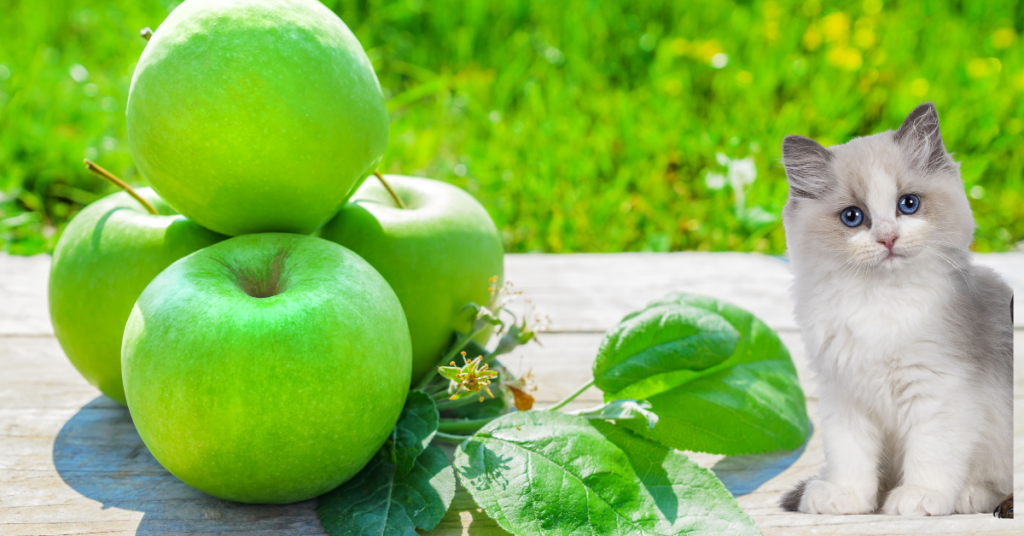
Yes, cats can eat green apples, but with the same precautions as with any other type of apple. Green apples are safe for cats, but they are typically more tart and less sweet than red varieties, which might make them less appealing to your cat. As with any apple, it’s crucial to remove the seeds, core, and peel to prevent any potential health risks.
Offer green apple slices in very small amounts, and observe how your cat reacts. Some cats might enjoy the different flavor, while others might be indifferent or even reject it. Keep in mind that apples should only be given as an occasional treat, not as a regular part of their diet.
Can cats eat red apples?
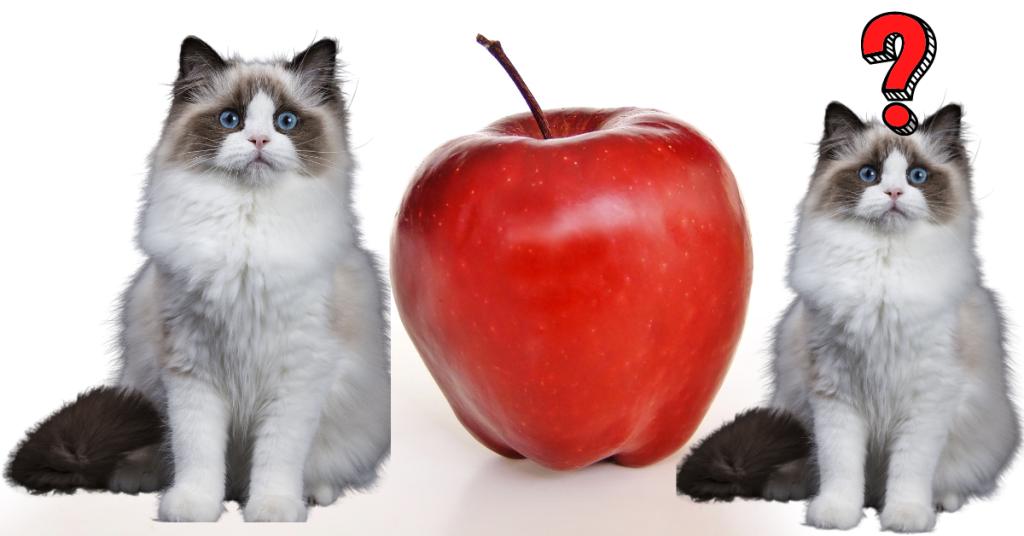
Yes, cats can eat red apples, but only in moderation and with some important precautions. Red apples, like other apple varieties, are safe for cats as long as the seeds, core, and peel are removed. The seeds contain harmful substances like cyanide, and the peel can be difficult for cats to digest.
Red apples tend to be sweeter, which might make them more appealing to some cats. However, because cats are obligate carnivores, they don’t need fruit in their diet. If you decide to give your cat a small piece of red apple, make sure it’s just an occasional treat and not a regular snack. Always watch for any signs of digestive discomfort and discontinue feeding apples if any issues arise.
Are apple cores poisonous to cats?
Yes, apple cores are poisonous to cats. The core, particularly the seeds, contains cyanogenic glycosides, which can release cyanide when chewed or digested. Cyanide is highly toxic and can cause serious health issues, including difficulty breathing, seizures, and even death in severe cases.
While a single apple seed may not cause immediate harm, it’s best not to take any risks. Always remove the core and seeds entirely before offering any apple to your cat. Stick to small, seedless slices of apple as an occasional treat, and avoid giving your cat access to the core altogether.
Even though the amount of cyanide in a single apple seed is small, cats are much smaller than humans, making them more susceptible to poisoning. Additionally, since cats tend to chew their food, they can easily break the seeds and release the cyanide. For these reasons, it’s crucial to completely remove the core and seeds before giving apples to cats to eliminate any risk of cyanide poisoning.
What fruits can cats eat besides apples?
Cats can enjoy a variety of fruits in moderation, as long as they’re prepared safely and served in small amounts. Here are some cat-safe fruits:
- Blueberries: Rich in antioxidants and fiber, blueberries can be a healthy treat for cats. They can be served fresh or frozen.
- Strawberries: These are also safe for cats and offer a sweet, juicy snack that’s high in vitamin C. Just remove the leaves and stems before offering them.
- Watermelon: A hydrating and refreshing treat, watermelon is safe as long as the seeds and rind are removed. It’s mostly water, making it a good option for hot days.
- Cantaloupe: Another melon that’s safe for cats, cantaloupe is sweet and hydrating. Remove the seeds and rind before serving.
- Bananas: High in potassium, bananas are a good occasional treat. They should be given in small pieces as they are high in sugar.
- Peeled Mango: Mango flesh is safe for cats, offering a sweet and tropical flavor. Be sure to remove the pit and peel before serving.
- Peeled Pears: Like apples, pears are safe when peeled and with seeds removed. Offer only a small amount due to their high sugar content.
- Peeled Peaches: The flesh of peaches is safe for cats, but the pit is toxic. Always remove the pit and peel before giving it to your cat.
Remember, while these fruits are safe, they should only be offered in small amounts as occasional treats. Cats are obligate carnivores, so their primary diet should consist of meat. Fruits should never replace their regular meals. Additionally, always introduce any new food gradually and monitor your cat for any signs of digestive upset.
Apple and cat health benefits
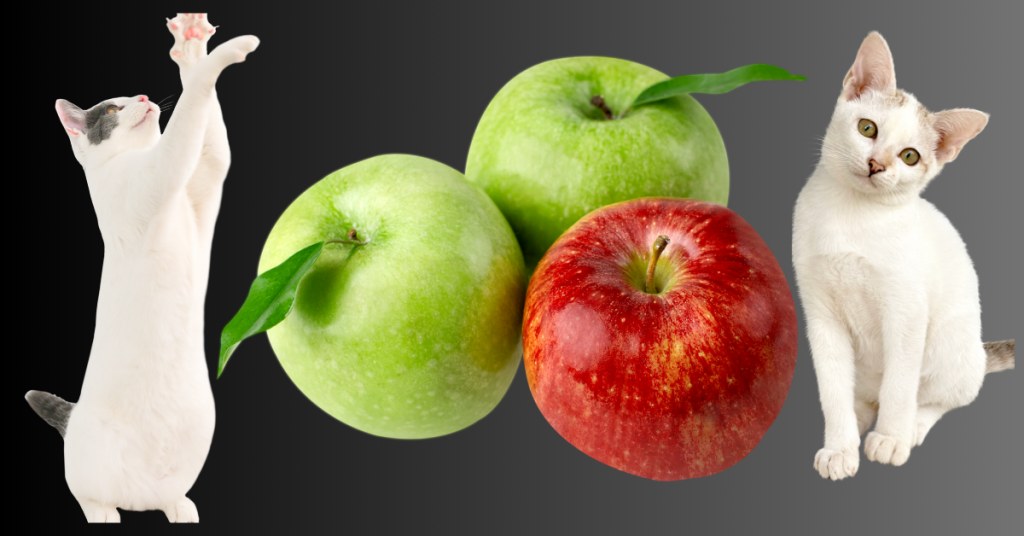
Apples can offer some health benefits to cats when given in small, controlled amounts. Here’s how apples might benefit your cat’s health:
Health Benefits of Apples for Cats
- Fiber Content: Apples are a good source of dietary fiber, which can aid in digestion and help regulate your cat’s bowel movements. Fiber can be especially helpful for cats that suffer from constipation.
- Vitamins: Apples contain vitamins such as vitamins C and A. While cats typically produce their own vitamin C, a small boost from an occasional apple slice can contribute to overall immune health. Vitamin A supports vision and skin health.
- Hydration: Apples have a high water content, which can help keep your cat hydrated, particularly if they’re not drinking enough water on their own. This is especially beneficial in warmer climates or during the summer months.
- Antioxidants: Apples are rich in antioxidants, which can help combat free radicals in the body. These antioxidants can contribute to long-term health by supporting the immune system and reducing the risk of chronic diseases.
Considerations
While apples offer these benefits, they should only be an occasional treat. Cats are obligate carnivores, meaning their bodies are designed to thrive on meat, and their primary nutritional needs should be met through a high-quality, meat-based diet. Fruits like apples should not make up a significant part of their diet but can be a healthy, low-calorie treat option when prepared properly (peeled and seed-free).
Are apples safe for kittens?
Apples can be safe for kittens but with extra caution. Here’s what to keep in mind:
Safety Guidelines for Feeding Apples to Kittens
- Small Portions: Kittens have smaller and more sensitive digestive systems than adult cats. If you choose to give a kitten a small taste of apple, make sure it’s just a tiny piece. Start with a small, bite-sized slice to see how they react.
- Remove Seeds and Core: The seeds and core of an apple are toxic because they contain cyanogenic glycosides, which can release cyanide when digested. Always remove these parts completely.
- Peel the Apple: The skin of an apple can be tough for kittens to digest and may cause an upset stomach. It’s best to peel the apple before offering it to your kitten.
- Observe for Reactions: Kittens are more prone to digestive upset than adult cats. After giving your kitten a small piece of apple, watch for any signs of discomfort, such as vomiting, diarrhea, or changes in behavior. If any of these occur, avoid giving apples in the future.
- Not a Dietary Staple: Apples, like other fruits, should not be a regular part of a kitten’s diet. Kittens need a diet rich in protein and fats to support their growth and development, which is best provided by a high-quality kitten food.
Conclusion
While apples can be safe for kittens when prepared properly, they should be given sparingly and only as an occasional treat. The primary focus of a kitten’s diet should be on nutrient-dense, meat-based foods to ensure they grow up healthy and strong. If you’re ever in doubt, it’s best to consult your veterinarian before introducing new foods to a kitten’s diet.


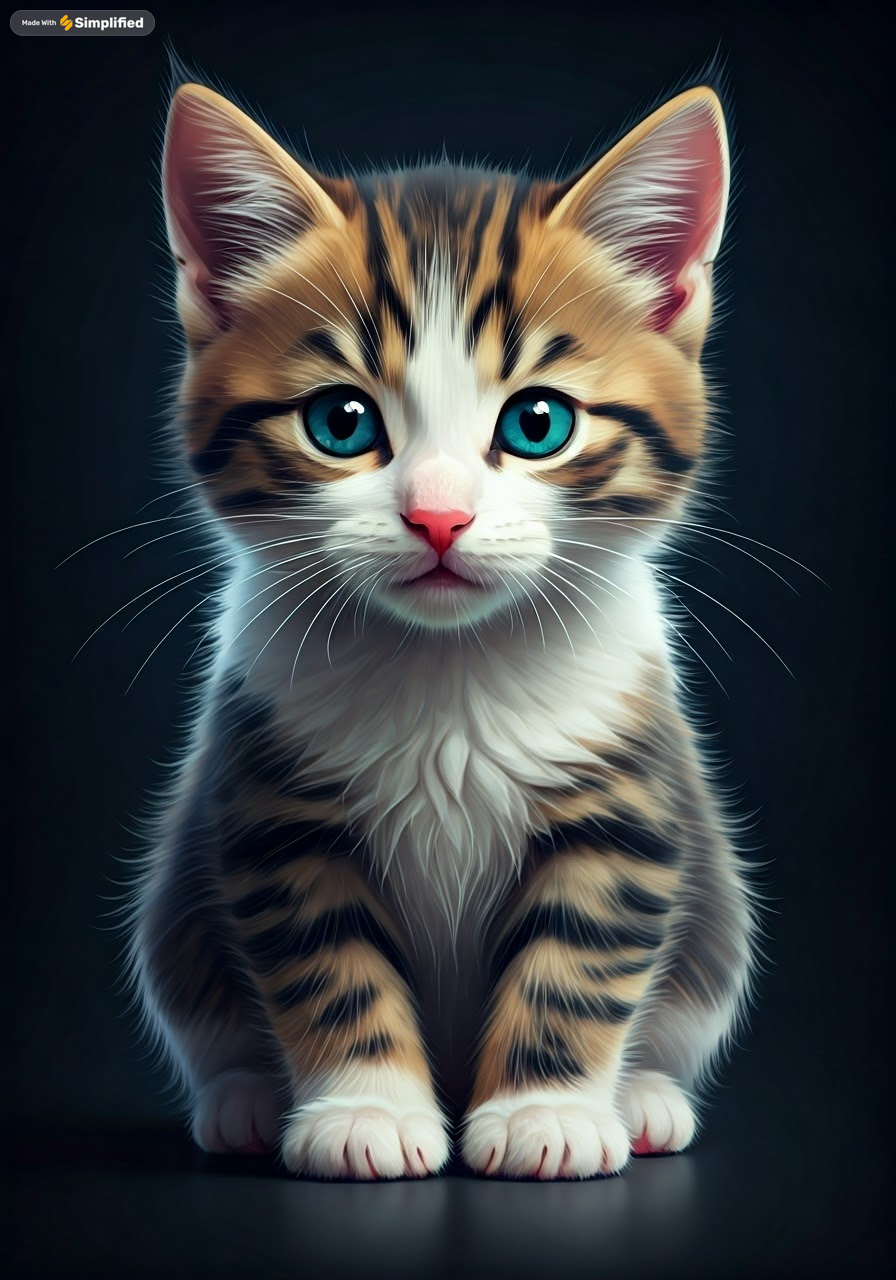
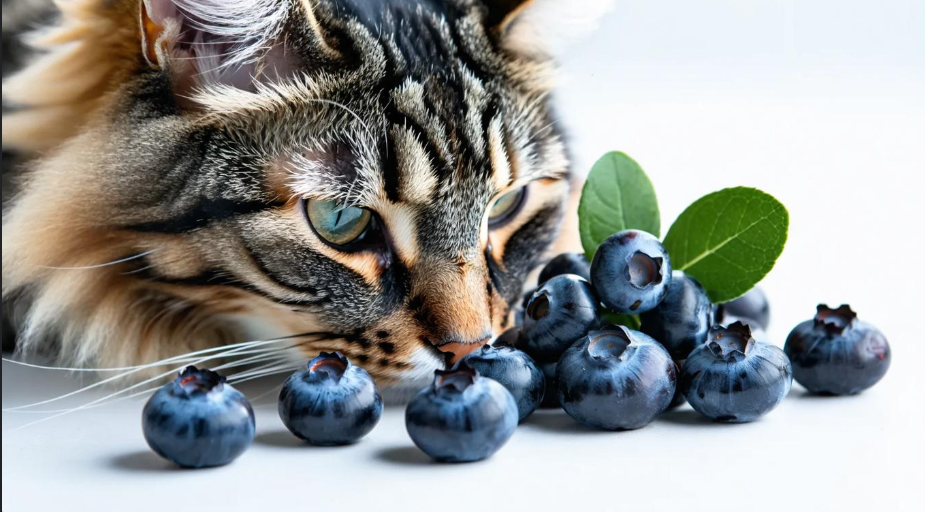


Leave a Reply